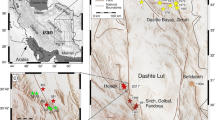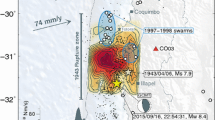Abstract
Results from the 2011 Mw 9.1 Tohoku-Oki megathrust earthquake display a complex rupture pattern, with most of the high-frequency energy radiated from the downdip edge of the seismogenic zone and very little from the large shallow rupture. Current seismic results of smaller earthquakes in this region are confusing due to disagreements among event catalogs on both the event locations (>30 km horizontally) and mechanisms. Here we present an in-depth study of a series of intraslab earthquakes that occurred in a localized region near the downdip edge of the main shock. We explore the validity of 1D velocity model and refine earthquake source parameters for selected key events by performing broadband waveform modeling combining regional networks. These refined source parameters are then used to calibrate paths and further simulate secondary source properties, such as rupture directivity and fault dimension. Calculation of stress changes caused by the main event indicate that the region where these intraslab events occurred are prone to thrust events. This group of intraslab earthquakes suggest the reactivation of a subducted normal fault, and are potentially useful in enhancing our understanding on the downdip shear zone and large outer-rise events.










Similar content being viewed by others
References
Ammon, C. J., Kanamori. H., and Lay, T (2008), A great earthquake doublet and seismic stress transfer cycle in the central Kuril Islands, Nature, 451(7178): 561–565.
Fujiwara, T., Kodaira, S., No, T., Kaiho, Y., Takahashi, N., and Kaneda, Y. (2011), The 2011 Tohoku-oki earthquake: Displacement reaching the trench axis, Science, 334(6060):1240–1240.
Graves, R. W. (1996), Simulating seismic wave propagation in 3d elastic media using staggered- grid finite differences, Bulletin of the Seismological Society of America, 86(4): 1091–1106.
Hartzell, S. H. (1978), Earthquake aftershocks as green’s functions, Geophysical Research Letters, 5(1):1–4.
Hasegawa, A., Yoshida, K., and Okada, T. (2011), Nearly complete stress drop in the 2011 Mw 9.0 off the Pacific coast of Tohoku earthquake, Earth, planets and space, 63 (7):703–707.
Helmberger, D. V. (1983), Theory and application of synthetic seismiograms, Earthquakes: Observation, Theory and Interpretation, H. Kanamori (Editor), pages 173–222.
Hino, R., Azuma, R., Ito, Y., Yamamoto, Y., Suzuki, K., Tsushima, H., Suzuki, S., Miyashita, M., Tomori, T., Arizono, M. (2009), Insight into complex rupturing of the immature bending normal fault in the outer slope of the Japan trench from aftershocks of the 2005 Sanriku earthquake (mw = 7.0) located by ocean bottom seismometry, Geochemistry, Geophysics, Geosystems, 10(7).
Huang, Y., Meng, L., and Ampuero, J.-P. (2012), A dynamic model of the frequency- dependent rupture process of the 2011 Tohoku-Oki earthquake, Earth Planets Space, 64 (12):1061–1066.
Huang, Y., Ampuero, J.-P., and Kanamori, H. (2013), Slip-weakening models of the 2011 Tohoku-Oki earthquake and constraints on stress drop and fracture energy, Pure and Applied Geophysics, pages 1–14.
Ide, S., Baltay, A., and Beroza, G. C. (2011), Shallow dynamic overshoot and energetic deep rupture in the 2011 Mw 9.0 Tohoku-Oki earthquake, Science, 332 (6036): 1426–1429.
Ito, Y., Tsuji, T., Osada, Y., Kido, M., Inazu, D., Hayashi, Y., Tsushima, H., Hino, R., and Fujimoto, H. (2011), Frontal wedge deformation near the source region of the 2011 Tohoku-Oki earthquake, Geophysical Research Letters, 38 (7).
Kanamori, H. (1971), Seismological evidence for a lithospheric normal faulting the Sanriku earthquake of 1933, Physics of the Earth and Planetary Interiors, 4 (4): 289–300.
Kato, A. and Igarashi, T. (2012), Regional extent of the large coseismic slip zone of the 2011 Mw 9.0 Tohoku-Oki earthquake delineated by on-fault aftershocks, Geophysical Research Letters, 39 (15).
Kato, A., Sakai, S., and Obara, K. (2011), A normal-faulting seismic sequence triggered by the 2011 off the pacific coast of Tohoku earthquake: Wholesale stress regime changes in the upper plate, Earth, planets and space, 63 (7): 745–748.
Koketsu, K., Miyake, H., Fujiwara, H., and Hashimoto, T. (2008), Progress towards a japan integrated velocity structure model and long-period ground motion hazard map, In Proceedings of the 14th World Conference on Earthquake Engineering, pages S10–038.
Lay, T., Ammon, C. J., Kanamori, H., Kim, M. J., and Xue, L. (2011), Outer trench-slope faulting and the 2011 Mw 9.0 off the pacific coast of Tohoku earthquake, Earth, planets and space, 63 (7): 713–718.
Lin, J. and Stein, R. S. (2004), Stress triggering in thrust and subduction earthquakes and stress interaction between the southern San Andreas and nearby thrust and strike-slip faults, Journal of Geophysical Research: Solid Earth (1978–2012), 109 (B2).
Nakajima, J., Hasegawa, A., and Kita, S. (2011), Seismic evidence for reactivation of a buried hydrated fault in the pacific slab by the 2011 M9.0 Tohoku earthquake, Geophysical Research Letters, 38 (7).
Ohta, Y., Miura, S., Ohzono, M., Kita, S., Iinuma, T., Demachi, T., Tachibana, K., Nakayama, T., Hirahara, S., Suzuki, S., et. al. (2011), Large intraslab earthquake (2011 April 7, M 7.1) after the 2011 off the Pacific coast of Tohoku earthquake (M 9.0): Coseismic fault model based on the dense GPS network data, Earth, planets and space, 63 (12): 1207–1211.
Simons, M., Minson, S. E., Sladen, A., Ortega, F., Jiang, J., Owen, S. E., Meng, L., Ampuero, J.-P., Wei, S., Chu, R., et al. (2011), The 2011 magnitude 9.0 Tohoku-Oki earthquake: Mosaicking the megathrust from seconds to centuries, Science, 332 (6036): 1421–1425.
Song, X. J. and Helmberger, D. V. (1996), Source estimation of finite faults from broadband regional networks, Bulletin of the Seismological Society of America, 86 (3): 797–804.
Tan, Y. and Helmberger, D. V. (2010), Rupture directivity characteristics of the 2003 Big Bear sequence, Bulletin of the Seismological Society of America, 100 (3): 1089–1106.
Toda, S., Stein, R. S., and Lin, J. (2011), Widespread seismicity excitation throughout central Japan following the 2011 M = 9.0 Tohoku earthquake and its interpretation by coulomb stress transfer, Geophysical Research Letters, 38 (7).
Wei, S., Graves, R., Helmberger, D. V., Avouac, J.-P., and Jiang, J. (2012), Sources of shaking and flooding during the Tohoku-Oki earthquake: A mixture of rupture styles, Earth and Planetary Science Letters, 333: 91–100.
Yue, H. and Lay, T. (2011), Inversion of high-rate (1 SPS) GPS data for rupture process of the 11 march 2011 Tohoku earthquake (Mw 9.1), Geophysical Research Letters, 38 (7).
Zhan, Z., Helmberger, D., Simons, M., Kanamori, H., Wu, W., Cubas, N., Duputel, Z., Chu, R., Tsai, V. C., Avouac, J.-P., et al. (2012), Anomalously steep dips of earthquakes in the 2011 Tohoku-Oki source region and possible explanations, Earth and Planetary Science Letters, 353: 121–133.
Zhang, Z., Chen, J. Y., and Lin, J. (2008), Stress interactions between normal faults and adjacent strike-slip faults of 1997 Jiashi earthquake swarm, Science in China Series D: Earth Sciences, 51 (3): 431–440.
Zhao, L.-S. and Helmberger, D. V. (1994), Source estimation from broadband regional seismograms, Bulletin of the Seismological Society of America, 84 (1): 91–104.
Zhu, L. and Helmberger, D. V. (1996), Advancement in source estimation techniques using broadband regional seismograms, Bulletin of the Seismological Society of America, 86 (5): 1634–1641.
Zhu, L. and Rivera, L. A. (2002), A note on the dynamic and static displacements from a point source in multilayered media, Geophysical Journal International, 148 (3): 619–627.
Acknowledgments
This study was supported by NSF Grant EAR-1142020. Broadband and Strong-motion waveforms were obtained from F-net, K-net, and Kik-Net of NIED. The Generic Mapping Tools (GMT) were used for creating some of the in-text figures. We would like to thank Hiroo Kanamori and Zhongwen Zhan for their insightful comments.
Author information
Authors and Affiliations
Corresponding author
Electronic supplementary material
Below is the link to the electronic supplementary material.
Appendix: Generating Empirical Green’s Functions
Appendix: Generating Empirical Green’s Functions
To generate empirical Green’s Functions using E2, based on the generalized ray theory (Helmberger 1983), the characteristic travel time of a generalized ray in a layered half-space is given by:
where r is the source-receiver distance, η i the vertical slowness of the ray in each layer, and d i the vertical distance of the ray segment in each layer. For two very close sources, the paths to the receiver will be highly similar in shape and differ only by a small time shift dt 0 . This time variance (dt 0 ) can be approximated by using Taylor series expansion for t 0 around the position of the point source (r, h).
∂t 0 /∂r is essentially p 0 , which is treated as a constant here. ∂t 0 /∂h = −εη s , where ε = 1 for down-going rays and ε = −1 for up-going rays. η s , which equals [(1/ν 2 s ) − p 2 0 ]1/2, is the vertical slowness of the ray p 0 in the source region. The velocity in the source region is represented by ν s . p 0 and η s in this study are numerical estimation from synthetics generated at different depths based on the 1D velocity model used for CAP inversion.
Here we assume E1 to be a finite-fault earthquake which is 45 times larger than E2 in moment magnitude. Thus, we discretize the rupture region into a line of 45 elements, each represented as an E2 point source. The total response (R (t)) of E1 at the receiver can then be represented by a summation of the 45 rays, each properly lagged in time according to the relative position from the reference point source.
Since we assume four rupture scenarios, diagonally northward and southward on the two auxiliary focal planes, there is a set of four empirical Green’s Functions R (t) generated, which is then compared with the data obtained to determine rupture directivity.
Rights and permissions
About this article
Cite this article
Lui, S.K.Y., Helmberger, D., Wei, S. et al. Interrogation of the Megathrust Zone in the Tohoku-Oki Seismic Region by Waveform Complexity: Intraslab Earthquake Rupture and Reactivation of Subducted Normal Faults. Pure Appl. Geophys. 172, 3425–3437 (2015). https://doi.org/10.1007/s00024-015-1042-9
Received:
Revised:
Accepted:
Published:
Issue Date:
DOI: https://doi.org/10.1007/s00024-015-1042-9




